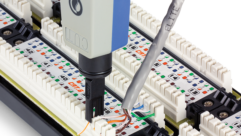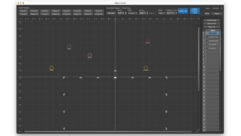

Not Quite Easy?Yet
button. It’s encouraging to get instant feedback on how smart you are. But it doesn’t always work that way.
THAT WAS (TOO) EASY
Sometimes, after coming up with an exceptionally clever idea or solution to a problem, you just want to tap that big red “Easy” button. It’s encouraging to get instant feedback on how smart you are. As the British say, “It’s just too twee.” Other times, I don’t know, I feel like punching the button out of frustration. Because, really, it isn’t as easy as it looks, and I don’t want to hear a disembodied voice proclaiming its superiority (“That was easy”). Some things just aren’t easy, and convincing yourself that they are can do more harm than good. Take audio system design.
When I first started in audio, the industry was paying careful attention to gain structure, impedance matching, and system signal-to-noise ratio. It was not unusual to look at the entire gain structure of a system—or to know which system devices were passive or active and how to ensure maximum signal gain. System gain had to be optimized to ensure that signal-to-noise was optimal as well. We were dealing with equipment that could induce thermal noise in the system that could be easily heard, and you had to be careful with the specifications of each device because the audience was listening.
As technology improved and the majority of professional audio equipment came with low-impedance, current-driven outputs, and bridging inputs, those concerns shrank. The systems would take care of themselves and things could be easily fixed during system commissioning. The systems were more forgiving.
In the digital age, it’s rare to hear about those old concerns. The signal-to-noise ratio of digital equipment is so high (90 dB or more) that achieving a real-world system signal-to-noise ratio of 50 dB to 60 dB is easy.
But we don’t install a single piece of equipment—we design and install integrated systems. In spite of our best efforts, most of those systems are increasingly complex. Some things have become so easy that we ignore complexity at our own peril and to the chagrin of our clients. In the process we have lost skills that were once commonplace.
How did this happen? Why do we tend to ignore important issues that so directly affect clients’ perceptions of the quality of their systems? Some of the problem comes from how easy it is to connect consumer-level gear at home and the false assumption that it’s just as easy in the commercial market.
There’s also bipolar marketing at work. We tell people it isn’t as easy as it looks, but at the same time our industry as a whole keeps trying to make it look (and act) easier. When all you have to worry about is whether your cables are properly polarized, connecting components is a breeze.
But we work against the best interests of our clients when we ignore basic issues. Only after they complain about the amount of money they spent on a poor-quality system and ask why they couldn’t have gone to the local AV retailer themselves, do we recognize what we’ve created. We can’t minimize basic audio issues and trust them to cure themselves. Clients expect high-quality professional AV systems because they’ve come to expect them from the consumer market.
One problem is, we don’t pay attention to correctly training our technical staff. An exercise in the CTS-I course involves connecting various pieces of equipment into a working system and then learning how to set up gain and optimize signal-to-noise in the system. More often than not, a technician will claim that it’s impossible to get a certain piece of gear to sound good—they’ve had nothing but problems with the equipment, they’ll argue, and no longer use it in their systems.
Not Quite Easy?Yet
button. It’s encouraging to get instant feedback on how smart you are. But it doesn’t always work that way.
REAL ROOT OF PROBLEMS
The problem isn’t with the gear. The vast majority of professional (and some consumer) equipment is well built and meets its minimum performance and technical specifications for signal-to-noise, gain, etc. The problem lies with technicians not understanding how to make the necessary measurements and adjustments to the gain structure of the system. Once they’ve been shown how to adjust the system and tried it themselves, the equipment or manufacturer comes off their “Don’t Touch” list.
A major reason our technical people sometimes have this mindset is that they do live in a digital world. We are seduced by technology’s promise that anything digital is automatically easier and better than analog, forgetting that the vast majority of systems still contain analog equipment and that a good portion of digital components are still analog-in and analog-out.
In a quick mental rundown of the systems I have designed over the past year, all of them had some analog equipment in them. Unless we pay attention to how those analog components are integrated with a digital core, the potential for gain and signal-to-noise problems remains. It is similar to case for using fiber optics, which promise to eliminate the potential for ground loops and induced noise. But that’s true only if the devices on each end of the fiber are already free of noise. If not, fiber can be just as effective at transmitting noise as it is at transmitting a clean signal.
I posed a series of questions to my fellow consultants a few weeks ago:
- How many of you currently require a contractor to measure and report electronic signal-to-noise ratios (SNR) in your specifications? If so, do you specify how that measurement will be made?
- If you don’t, do you take that measurement yourself without the contractor’s assistance?
- Are your SNR specs the same for every venue? How do they differ?
- What share of contractors do you think actually know how to take the measurement?
These are issues that the Electronic Audio Noise Task Group, a part of the Project Commissioning Working Group (PCWG), is working through as it defines the how and the why of electronic audio noise measurement and system gain optimization. The PCWG has been organized by InfoComm International as part of an effort to create a suite of best practices that will help guide the industry through the process of commissioning audiovisual systems.
It is not something that will take place overnight or without the efforts of the entire industry. The Noise Task Group comprises manufacturers, consultants, and system integrators. We all recognize the vital role that well designed, properly installed, and adequately commissioned audiovisual systems play in the health of our industry and the satisfaction of our clients.
Hopefully we’ll all get to tap that “Easy” button as we work to understand the importance of this issue (among others) and train installation staff in proper commissioning procedures. The result will be a greater level of confidence in our knowledge and capabilities. This translates directly to the bottom line and profitability of our industry.
That should be really easy.
Thom Mullins is a senior consultant with BRC Acoustics & Technology Consulting in Seattle. He can be reached at [email protected].










